Qualitative Research Report: Analysis of Diabetes Mellitus Experience
VerifiedAdded on 2021/05/31
|11
|2332
|68
Report
AI Summary
This qualitative research report examines the lived experiences of patients with diabetes mellitus, a chronic metabolic disorder characterized by elevated blood sugar levels. The report delves into the symptoms, complications, and treatment strategies associated with the condition, emphasizing the importance of lifestyle changes, medication, and continuous monitoring. It explores the search strategy employed, including the use of Google Scholar, books, and journals, and reviews key findings from selected articles. The report highlights the critical role of nurses in providing patient care, including medication administration, lifestyle support, and monitoring for complications. Key findings reveal the increased risk of various health issues associated with diabetes, underscoring the need for comprehensive management approaches. The report concludes with reflections on key learnings and emphasizes the importance of patient-centered care and support in managing the condition effectively. The report also includes a list of references for further reading and research.
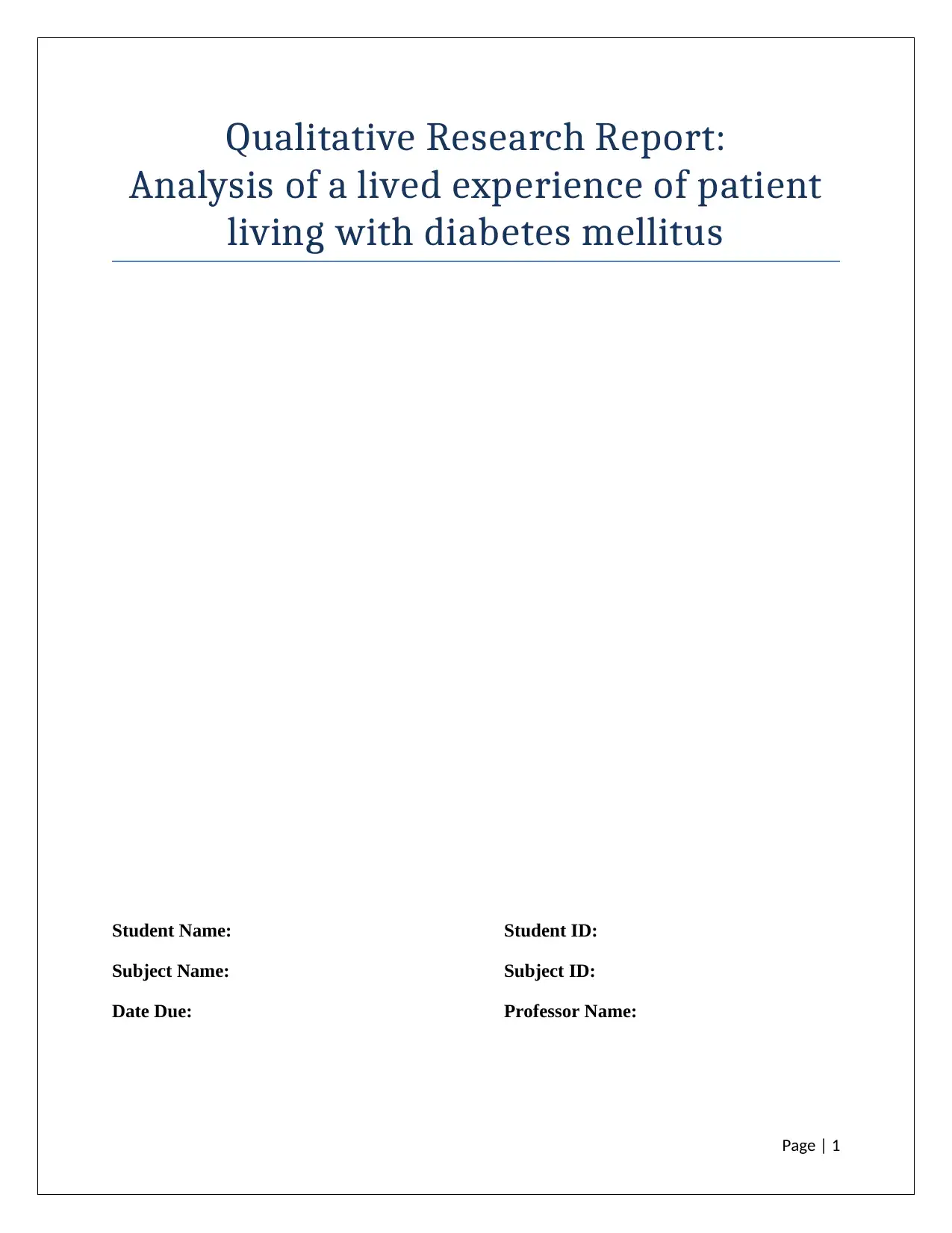
Qualitative Research Report:
Analysis of a lived experience of patient
living with diabetes mellitus
Student Name: Student ID:
Subject Name: Subject ID:
Date Due: Professor Name:
Page | 1
Analysis of a lived experience of patient
living with diabetes mellitus
Student Name: Student ID:
Subject Name: Subject ID:
Date Due: Professor Name:
Page | 1
Paraphrase This Document
Need a fresh take? Get an instant paraphrase of this document with our AI Paraphraser
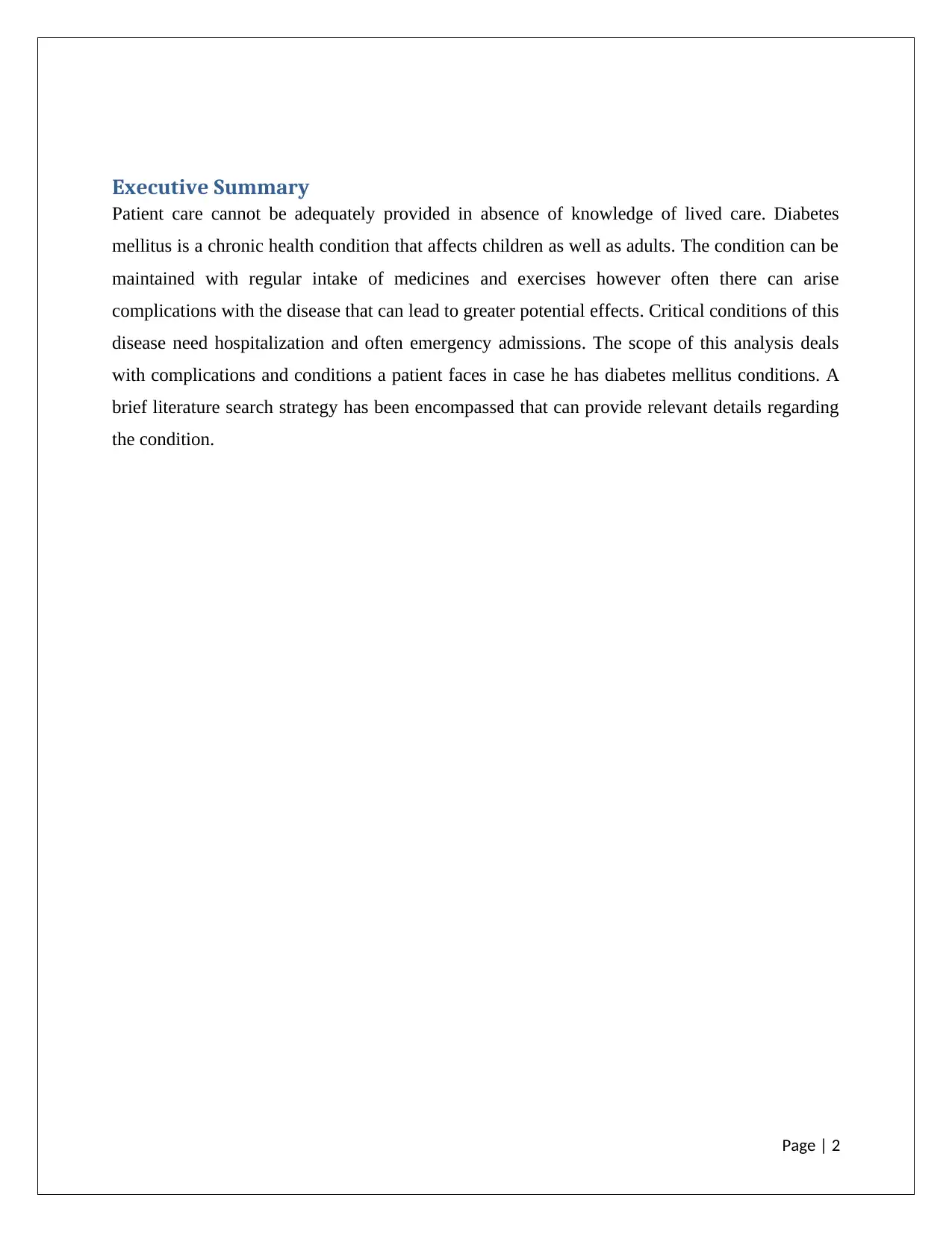
Executive Summary
Patient care cannot be adequately provided in absence of knowledge of lived care. Diabetes
mellitus is a chronic health condition that affects children as well as adults. The condition can be
maintained with regular intake of medicines and exercises however often there can arise
complications with the disease that can lead to greater potential effects. Critical conditions of this
disease need hospitalization and often emergency admissions. The scope of this analysis deals
with complications and conditions a patient faces in case he has diabetes mellitus conditions. A
brief literature search strategy has been encompassed that can provide relevant details regarding
the condition.
Page | 2
Patient care cannot be adequately provided in absence of knowledge of lived care. Diabetes
mellitus is a chronic health condition that affects children as well as adults. The condition can be
maintained with regular intake of medicines and exercises however often there can arise
complications with the disease that can lead to greater potential effects. Critical conditions of this
disease need hospitalization and often emergency admissions. The scope of this analysis deals
with complications and conditions a patient faces in case he has diabetes mellitus conditions. A
brief literature search strategy has been encompassed that can provide relevant details regarding
the condition.
Page | 2
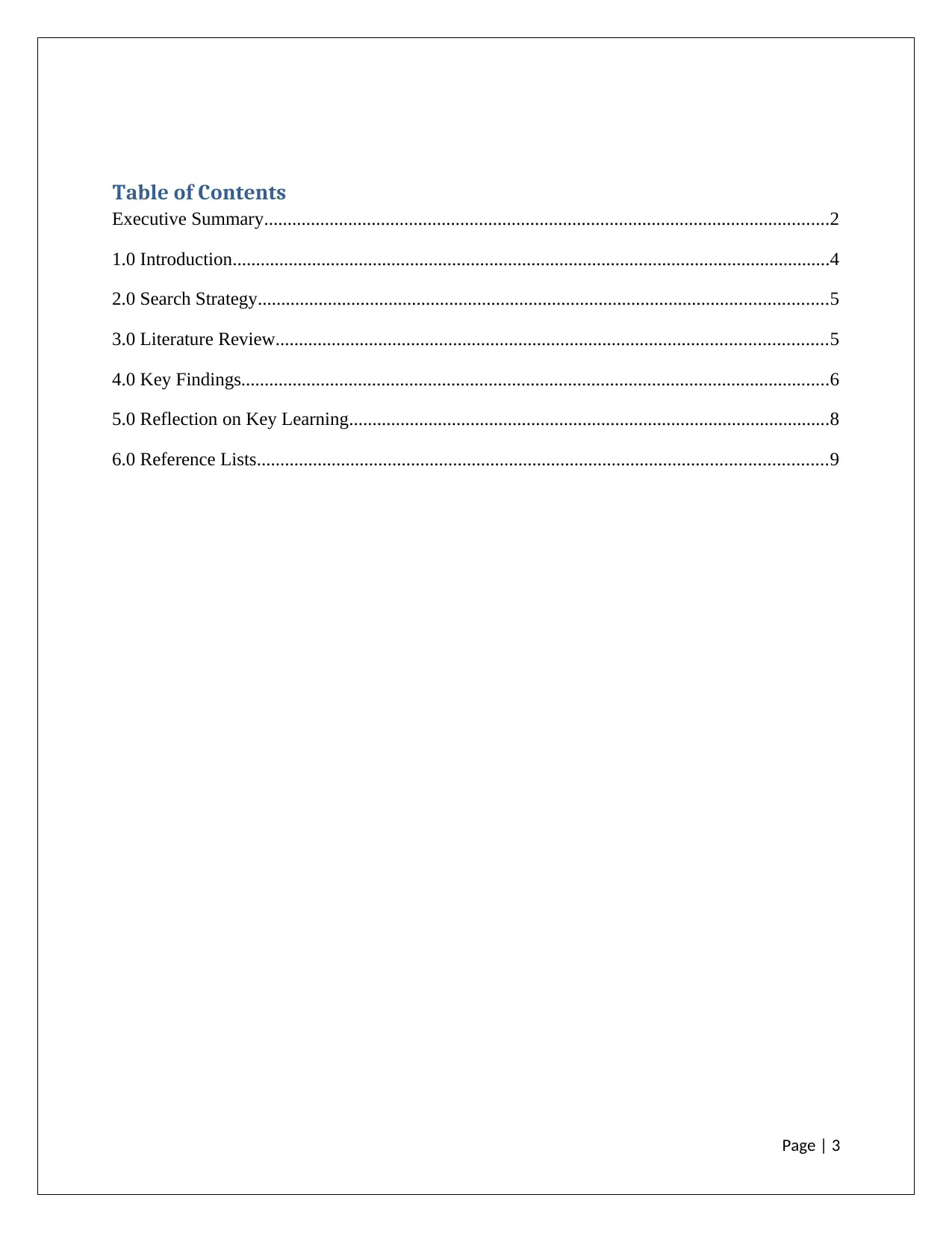
Table of Contents
Executive Summary.........................................................................................................................2
1.0 Introduction................................................................................................................................4
2.0 Search Strategy..........................................................................................................................5
3.0 Literature Review......................................................................................................................5
4.0 Key Findings..............................................................................................................................6
5.0 Reflection on Key Learning.......................................................................................................8
6.0 Reference Lists..........................................................................................................................9
Page | 3
Executive Summary.........................................................................................................................2
1.0 Introduction................................................................................................................................4
2.0 Search Strategy..........................................................................................................................5
3.0 Literature Review......................................................................................................................5
4.0 Key Findings..............................................................................................................................6
5.0 Reflection on Key Learning.......................................................................................................8
6.0 Reference Lists..........................................................................................................................9
Page | 3
⊘ This is a preview!⊘
Do you want full access?
Subscribe today to unlock all pages.

Trusted by 1+ million students worldwide
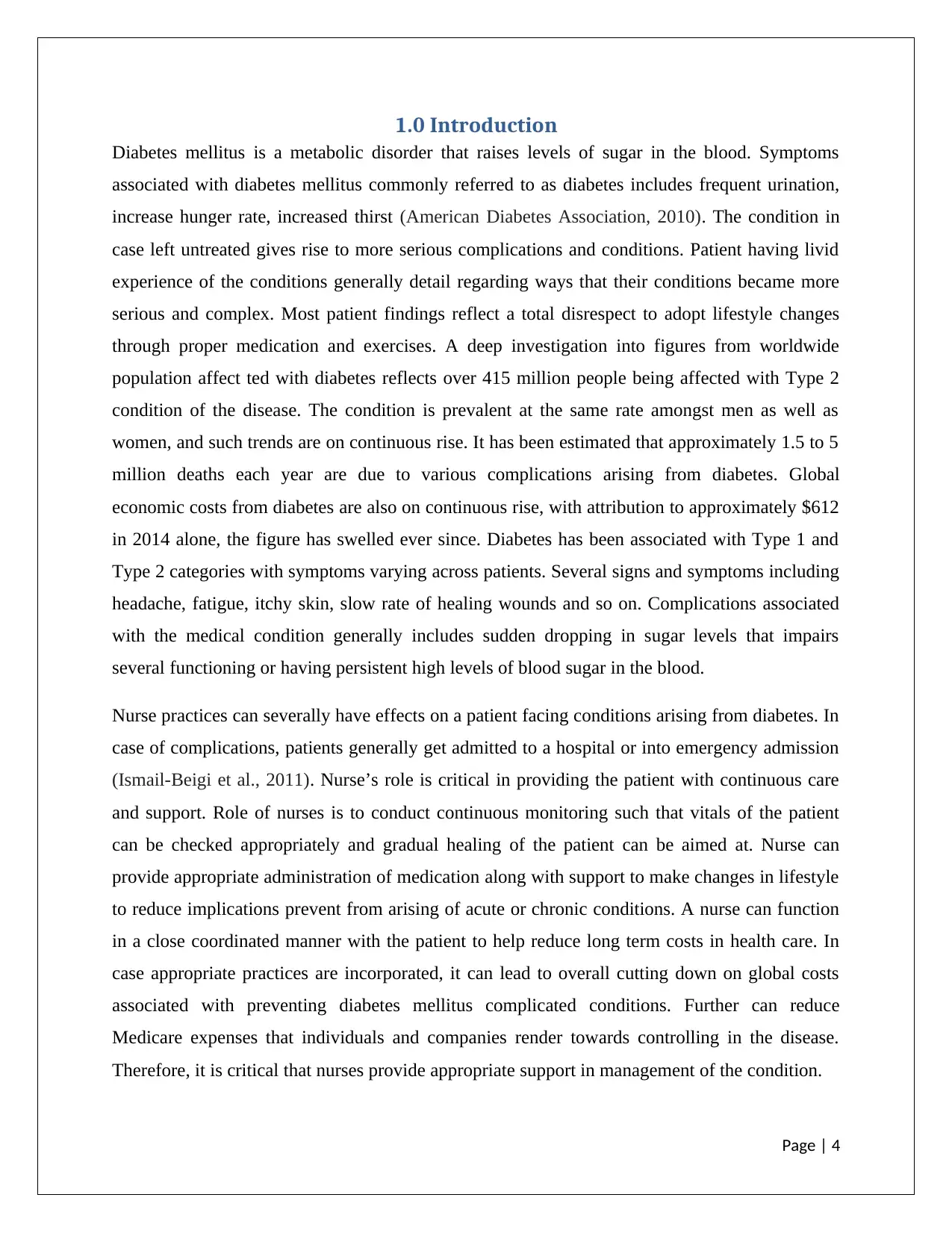
1.0 Introduction
Diabetes mellitus is a metabolic disorder that raises levels of sugar in the blood. Symptoms
associated with diabetes mellitus commonly referred to as diabetes includes frequent urination,
increase hunger rate, increased thirst (American Diabetes Association, 2010). The condition in
case left untreated gives rise to more serious complications and conditions. Patient having livid
experience of the conditions generally detail regarding ways that their conditions became more
serious and complex. Most patient findings reflect a total disrespect to adopt lifestyle changes
through proper medication and exercises. A deep investigation into figures from worldwide
population affect ted with diabetes reflects over 415 million people being affected with Type 2
condition of the disease. The condition is prevalent at the same rate amongst men as well as
women, and such trends are on continuous rise. It has been estimated that approximately 1.5 to 5
million deaths each year are due to various complications arising from diabetes. Global
economic costs from diabetes are also on continuous rise, with attribution to approximately $612
in 2014 alone, the figure has swelled ever since. Diabetes has been associated with Type 1 and
Type 2 categories with symptoms varying across patients. Several signs and symptoms including
headache, fatigue, itchy skin, slow rate of healing wounds and so on. Complications associated
with the medical condition generally includes sudden dropping in sugar levels that impairs
several functioning or having persistent high levels of blood sugar in the blood.
Nurse practices can severally have effects on a patient facing conditions arising from diabetes. In
case of complications, patients generally get admitted to a hospital or into emergency admission
(Ismail-Beigi et al., 2011). Nurse’s role is critical in providing the patient with continuous care
and support. Role of nurses is to conduct continuous monitoring such that vitals of the patient
can be checked appropriately and gradual healing of the patient can be aimed at. Nurse can
provide appropriate administration of medication along with support to make changes in lifestyle
to reduce implications prevent from arising of acute or chronic conditions. A nurse can function
in a close coordinated manner with the patient to help reduce long term costs in health care. In
case appropriate practices are incorporated, it can lead to overall cutting down on global costs
associated with preventing diabetes mellitus complicated conditions. Further can reduce
Medicare expenses that individuals and companies render towards controlling in the disease.
Therefore, it is critical that nurses provide appropriate support in management of the condition.
Page | 4
Diabetes mellitus is a metabolic disorder that raises levels of sugar in the blood. Symptoms
associated with diabetes mellitus commonly referred to as diabetes includes frequent urination,
increase hunger rate, increased thirst (American Diabetes Association, 2010). The condition in
case left untreated gives rise to more serious complications and conditions. Patient having livid
experience of the conditions generally detail regarding ways that their conditions became more
serious and complex. Most patient findings reflect a total disrespect to adopt lifestyle changes
through proper medication and exercises. A deep investigation into figures from worldwide
population affect ted with diabetes reflects over 415 million people being affected with Type 2
condition of the disease. The condition is prevalent at the same rate amongst men as well as
women, and such trends are on continuous rise. It has been estimated that approximately 1.5 to 5
million deaths each year are due to various complications arising from diabetes. Global
economic costs from diabetes are also on continuous rise, with attribution to approximately $612
in 2014 alone, the figure has swelled ever since. Diabetes has been associated with Type 1 and
Type 2 categories with symptoms varying across patients. Several signs and symptoms including
headache, fatigue, itchy skin, slow rate of healing wounds and so on. Complications associated
with the medical condition generally includes sudden dropping in sugar levels that impairs
several functioning or having persistent high levels of blood sugar in the blood.
Nurse practices can severally have effects on a patient facing conditions arising from diabetes. In
case of complications, patients generally get admitted to a hospital or into emergency admission
(Ismail-Beigi et al., 2011). Nurse’s role is critical in providing the patient with continuous care
and support. Role of nurses is to conduct continuous monitoring such that vitals of the patient
can be checked appropriately and gradual healing of the patient can be aimed at. Nurse can
provide appropriate administration of medication along with support to make changes in lifestyle
to reduce implications prevent from arising of acute or chronic conditions. A nurse can function
in a close coordinated manner with the patient to help reduce long term costs in health care. In
case appropriate practices are incorporated, it can lead to overall cutting down on global costs
associated with preventing diabetes mellitus complicated conditions. Further can reduce
Medicare expenses that individuals and companies render towards controlling in the disease.
Therefore, it is critical that nurses provide appropriate support in management of the condition.
Page | 4
Paraphrase This Document
Need a fresh take? Get an instant paraphrase of this document with our AI Paraphraser

2.0 Search Strategy
As search strategy was critical to arrive at understanding related to the topic. As there was no
scope for taking in practical exposure and learning from patient having livid experience of the
condition, we had to undertake search strategy from various books, journals and internet sources.
In order to complete this qualitative research for the proposed condition of patient having
diabetes mellitus, I had mainly made use of Google Scholar (Lewis, 2015). I also made use of
several books that was present in our library and made use of internet sources. There was an
extensive array of books and journals that I arrived at, that could provide relevant insight into
patient having livid experience. But due to time constraint I had to select three appropriate
journals and go through them to arrive at findings related to the study.
3.0 Literature Review
In order to conduct this study there are three journal sources that has been made use of. Below is
mentioned key research procedure and methods that has been used by these journals.
Article 1 by From, Scott and Chen (2010).
Research aim: Research aim of this study was to understand patients with diabetes mellitus
having high prevalence from pre-clinical diastolic dysfunction.
Research design: The scholars here had adopted qualitative as well as quantitative research
design in order to arrive at results for the study.
Participants: The study made use of 1,760 diabetic mellitus patient’s.
Data collection: The scholar had made use of primary data collection of quantitative data by
using experimental procedures.
Page | 5
As search strategy was critical to arrive at understanding related to the topic. As there was no
scope for taking in practical exposure and learning from patient having livid experience of the
condition, we had to undertake search strategy from various books, journals and internet sources.
In order to complete this qualitative research for the proposed condition of patient having
diabetes mellitus, I had mainly made use of Google Scholar (Lewis, 2015). I also made use of
several books that was present in our library and made use of internet sources. There was an
extensive array of books and journals that I arrived at, that could provide relevant insight into
patient having livid experience. But due to time constraint I had to select three appropriate
journals and go through them to arrive at findings related to the study.
3.0 Literature Review
In order to conduct this study there are three journal sources that has been made use of. Below is
mentioned key research procedure and methods that has been used by these journals.
Article 1 by From, Scott and Chen (2010).
Research aim: Research aim of this study was to understand patients with diabetes mellitus
having high prevalence from pre-clinical diastolic dysfunction.
Research design: The scholars here had adopted qualitative as well as quantitative research
design in order to arrive at results for the study.
Participants: The study made use of 1,760 diabetic mellitus patient’s.
Data collection: The scholar had made use of primary data collection of quantitative data by
using experimental procedures.
Page | 5
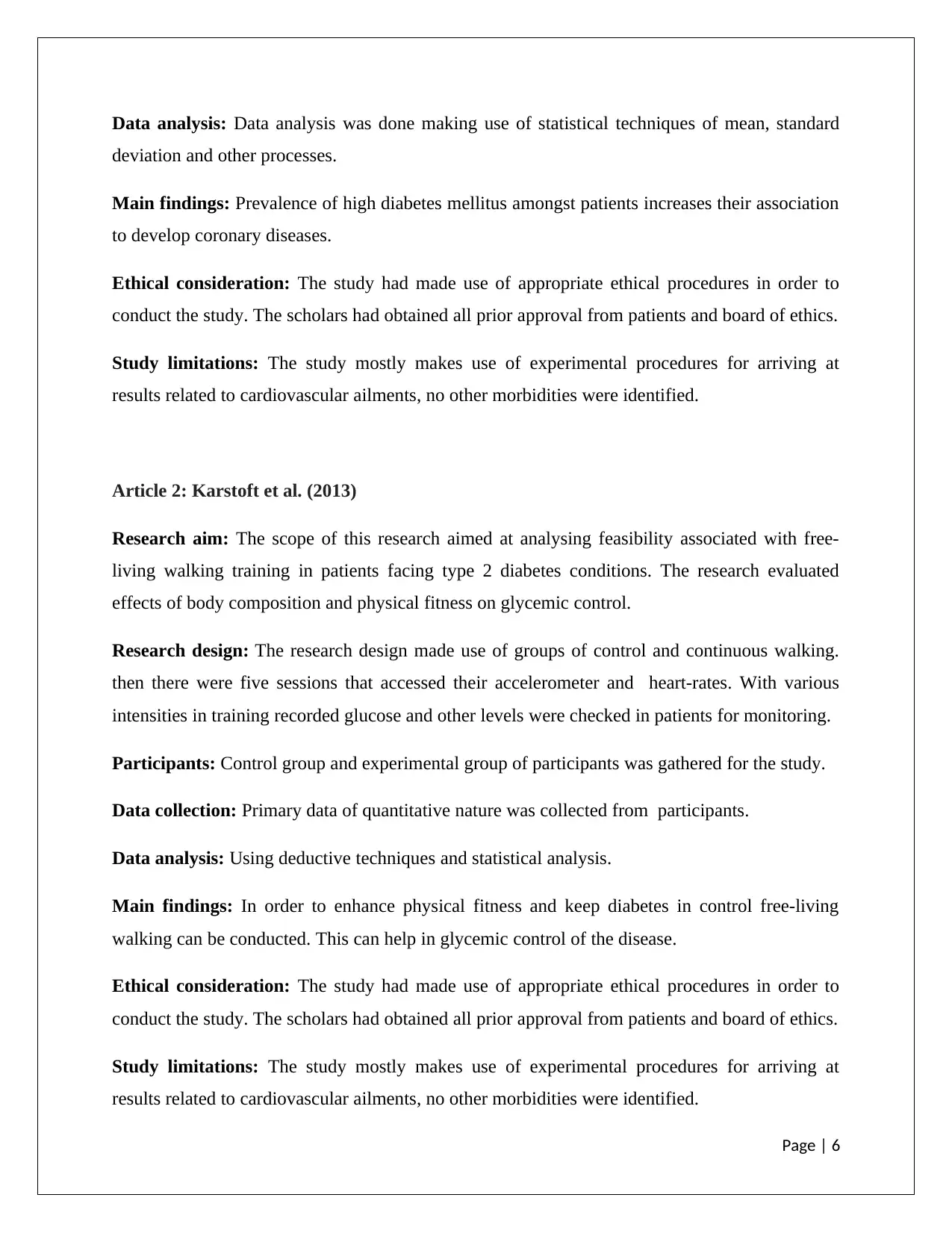
Data analysis: Data analysis was done making use of statistical techniques of mean, standard
deviation and other processes.
Main findings: Prevalence of high diabetes mellitus amongst patients increases their association
to develop coronary diseases.
Ethical consideration: The study had made use of appropriate ethical procedures in order to
conduct the study. The scholars had obtained all prior approval from patients and board of ethics.
Study limitations: The study mostly makes use of experimental procedures for arriving at
results related to cardiovascular ailments, no other morbidities were identified.
Article 2: Karstoft et al. (2013)
Research aim: The scope of this research aimed at analysing feasibility associated with free-
living walking training in patients facing type 2 diabetes conditions. The research evaluated
effects of body composition and physical fitness on glycemic control.
Research design: The research design made use of groups of control and continuous walking.
then there were five sessions that accessed their accelerometer and heart-rates. With various
intensities in training recorded glucose and other levels were checked in patients for monitoring.
Participants: Control group and experimental group of participants was gathered for the study.
Data collection: Primary data of quantitative nature was collected from participants.
Data analysis: Using deductive techniques and statistical analysis.
Main findings: In order to enhance physical fitness and keep diabetes in control free-living
walking can be conducted. This can help in glycemic control of the disease.
Ethical consideration: The study had made use of appropriate ethical procedures in order to
conduct the study. The scholars had obtained all prior approval from patients and board of ethics.
Study limitations: The study mostly makes use of experimental procedures for arriving at
results related to cardiovascular ailments, no other morbidities were identified.
Page | 6
deviation and other processes.
Main findings: Prevalence of high diabetes mellitus amongst patients increases their association
to develop coronary diseases.
Ethical consideration: The study had made use of appropriate ethical procedures in order to
conduct the study. The scholars had obtained all prior approval from patients and board of ethics.
Study limitations: The study mostly makes use of experimental procedures for arriving at
results related to cardiovascular ailments, no other morbidities were identified.
Article 2: Karstoft et al. (2013)
Research aim: The scope of this research aimed at analysing feasibility associated with free-
living walking training in patients facing type 2 diabetes conditions. The research evaluated
effects of body composition and physical fitness on glycemic control.
Research design: The research design made use of groups of control and continuous walking.
then there were five sessions that accessed their accelerometer and heart-rates. With various
intensities in training recorded glucose and other levels were checked in patients for monitoring.
Participants: Control group and experimental group of participants was gathered for the study.
Data collection: Primary data of quantitative nature was collected from participants.
Data analysis: Using deductive techniques and statistical analysis.
Main findings: In order to enhance physical fitness and keep diabetes in control free-living
walking can be conducted. This can help in glycemic control of the disease.
Ethical consideration: The study had made use of appropriate ethical procedures in order to
conduct the study. The scholars had obtained all prior approval from patients and board of ethics.
Study limitations: The study mostly makes use of experimental procedures for arriving at
results related to cardiovascular ailments, no other morbidities were identified.
Page | 6
⊘ This is a preview!⊘
Do you want full access?
Subscribe today to unlock all pages.

Trusted by 1+ million students worldwide

Article 3 is by Stolar (2010)
Research aim: Complications arising from type 2 diabetes
Research design: B Qualitative research design
Participants: Collected from hiospitals
Data collection: Qualitative and primary level data was collected.
Data analysis: Deductive procedures
Main findings: Diabetes of type 2 increases complications in patients leading to rise in
morbidities.
Ethical consideration: The study had made use of appropriate ethical procedures in order to
conduct the study. The scholars had obtained all prior approval from patients and board of ethics.
Study limitations: The study mostly makes use of experimental procedures for arriving at
results related to cardiovascular ailments, no other morbidities were identified.
4.0 Key Findings
Key findings from several journals analysed in this research reflects high incidence of several
associated conditions arising from diabetes mellitus. Meaning that diabetes mellitus increases or
enhances rates or other diseases. It increase morbidities that are often difficult to manage
(Nalysnyk, Hernandez‐Medina & Krishnarajah, 2010). As all study conducted analyses diabetes
as a co-conditions therefore all research findings need to be directed and aimed at reducing or
managing conditions related to diabetes conditions. A more comprehensive procedure and
management techniques has to be accommodated that allows overcoming situation that increase
Page | 7
Research aim: Complications arising from type 2 diabetes
Research design: B Qualitative research design
Participants: Collected from hiospitals
Data collection: Qualitative and primary level data was collected.
Data analysis: Deductive procedures
Main findings: Diabetes of type 2 increases complications in patients leading to rise in
morbidities.
Ethical consideration: The study had made use of appropriate ethical procedures in order to
conduct the study. The scholars had obtained all prior approval from patients and board of ethics.
Study limitations: The study mostly makes use of experimental procedures for arriving at
results related to cardiovascular ailments, no other morbidities were identified.
4.0 Key Findings
Key findings from several journals analysed in this research reflects high incidence of several
associated conditions arising from diabetes mellitus. Meaning that diabetes mellitus increases or
enhances rates or other diseases. It increase morbidities that are often difficult to manage
(Nalysnyk, Hernandez‐Medina & Krishnarajah, 2010). As all study conducted analyses diabetes
as a co-conditions therefore all research findings need to be directed and aimed at reducing or
managing conditions related to diabetes conditions. A more comprehensive procedure and
management techniques has to be accommodated that allows overcoming situation that increase
Page | 7
Paraphrase This Document
Need a fresh take? Get an instant paraphrase of this document with our AI Paraphraser
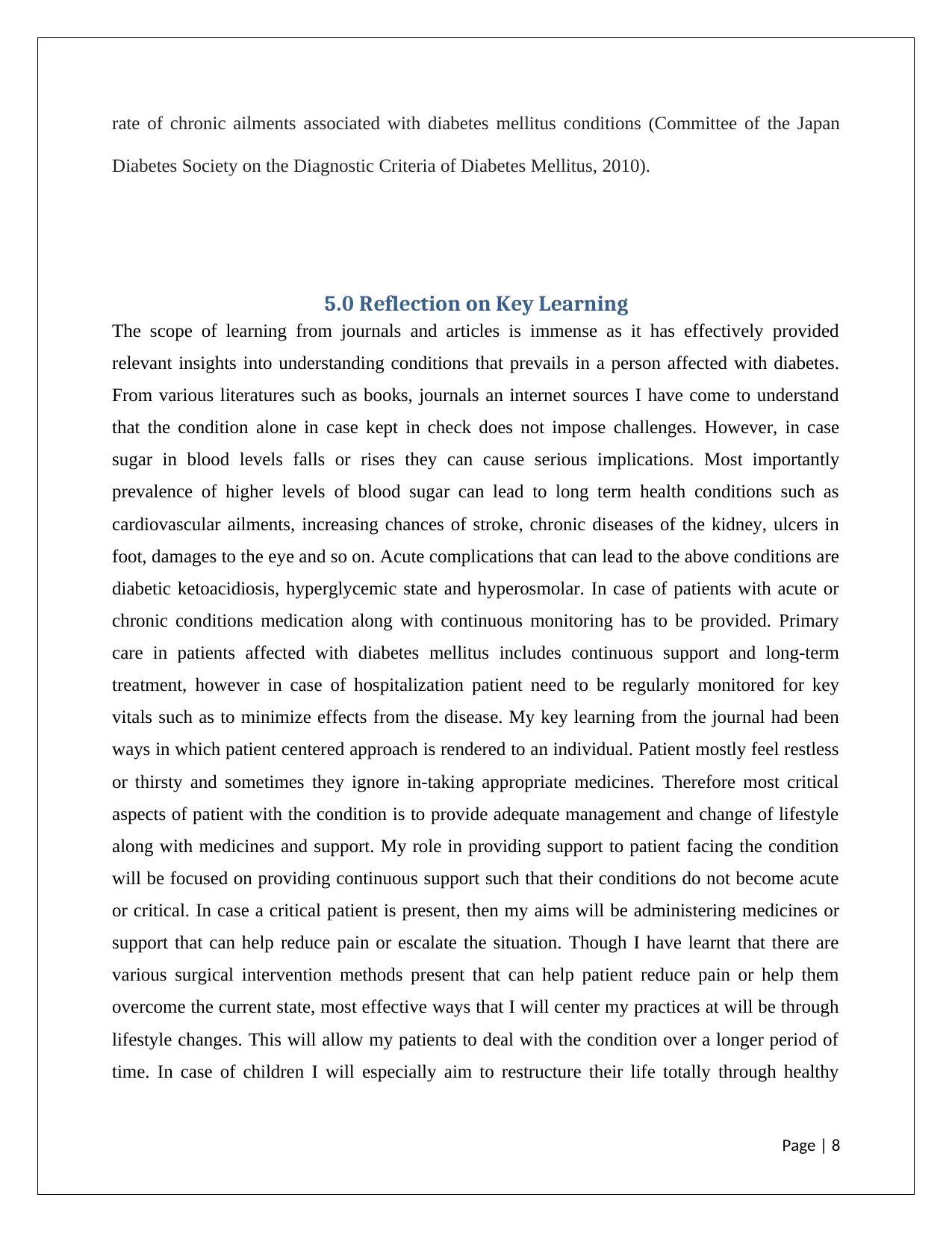
rate of chronic ailments associated with diabetes mellitus conditions (Committee of the Japan
Diabetes Society on the Diagnostic Criteria of Diabetes Mellitus, 2010).
5.0 Reflection on Key Learning
The scope of learning from journals and articles is immense as it has effectively provided
relevant insights into understanding conditions that prevails in a person affected with diabetes.
From various literatures such as books, journals an internet sources I have come to understand
that the condition alone in case kept in check does not impose challenges. However, in case
sugar in blood levels falls or rises they can cause serious implications. Most importantly
prevalence of higher levels of blood sugar can lead to long term health conditions such as
cardiovascular ailments, increasing chances of stroke, chronic diseases of the kidney, ulcers in
foot, damages to the eye and so on. Acute complications that can lead to the above conditions are
diabetic ketoacidiosis, hyperglycemic state and hyperosmolar. In case of patients with acute or
chronic conditions medication along with continuous monitoring has to be provided. Primary
care in patients affected with diabetes mellitus includes continuous support and long-term
treatment, however in case of hospitalization patient need to be regularly monitored for key
vitals such as to minimize effects from the disease. My key learning from the journal had been
ways in which patient centered approach is rendered to an individual. Patient mostly feel restless
or thirsty and sometimes they ignore in-taking appropriate medicines. Therefore most critical
aspects of patient with the condition is to provide adequate management and change of lifestyle
along with medicines and support. My role in providing support to patient facing the condition
will be focused on providing continuous support such that their conditions do not become acute
or critical. In case a critical patient is present, then my aims will be administering medicines or
support that can help reduce pain or escalate the situation. Though I have learnt that there are
various surgical intervention methods present that can help patient reduce pain or help them
overcome the current state, most effective ways that I will center my practices at will be through
lifestyle changes. This will allow my patients to deal with the condition over a longer period of
time. In case of children I will especially aim to restructure their life totally through healthy
Page | 8
Diabetes Society on the Diagnostic Criteria of Diabetes Mellitus, 2010).
5.0 Reflection on Key Learning
The scope of learning from journals and articles is immense as it has effectively provided
relevant insights into understanding conditions that prevails in a person affected with diabetes.
From various literatures such as books, journals an internet sources I have come to understand
that the condition alone in case kept in check does not impose challenges. However, in case
sugar in blood levels falls or rises they can cause serious implications. Most importantly
prevalence of higher levels of blood sugar can lead to long term health conditions such as
cardiovascular ailments, increasing chances of stroke, chronic diseases of the kidney, ulcers in
foot, damages to the eye and so on. Acute complications that can lead to the above conditions are
diabetic ketoacidiosis, hyperglycemic state and hyperosmolar. In case of patients with acute or
chronic conditions medication along with continuous monitoring has to be provided. Primary
care in patients affected with diabetes mellitus includes continuous support and long-term
treatment, however in case of hospitalization patient need to be regularly monitored for key
vitals such as to minimize effects from the disease. My key learning from the journal had been
ways in which patient centered approach is rendered to an individual. Patient mostly feel restless
or thirsty and sometimes they ignore in-taking appropriate medicines. Therefore most critical
aspects of patient with the condition is to provide adequate management and change of lifestyle
along with medicines and support. My role in providing support to patient facing the condition
will be focused on providing continuous support such that their conditions do not become acute
or critical. In case a critical patient is present, then my aims will be administering medicines or
support that can help reduce pain or escalate the situation. Though I have learnt that there are
various surgical intervention methods present that can help patient reduce pain or help them
overcome the current state, most effective ways that I will center my practices at will be through
lifestyle changes. This will allow my patients to deal with the condition over a longer period of
time. In case of children I will especially aim to restructure their life totally through healthy
Page | 8
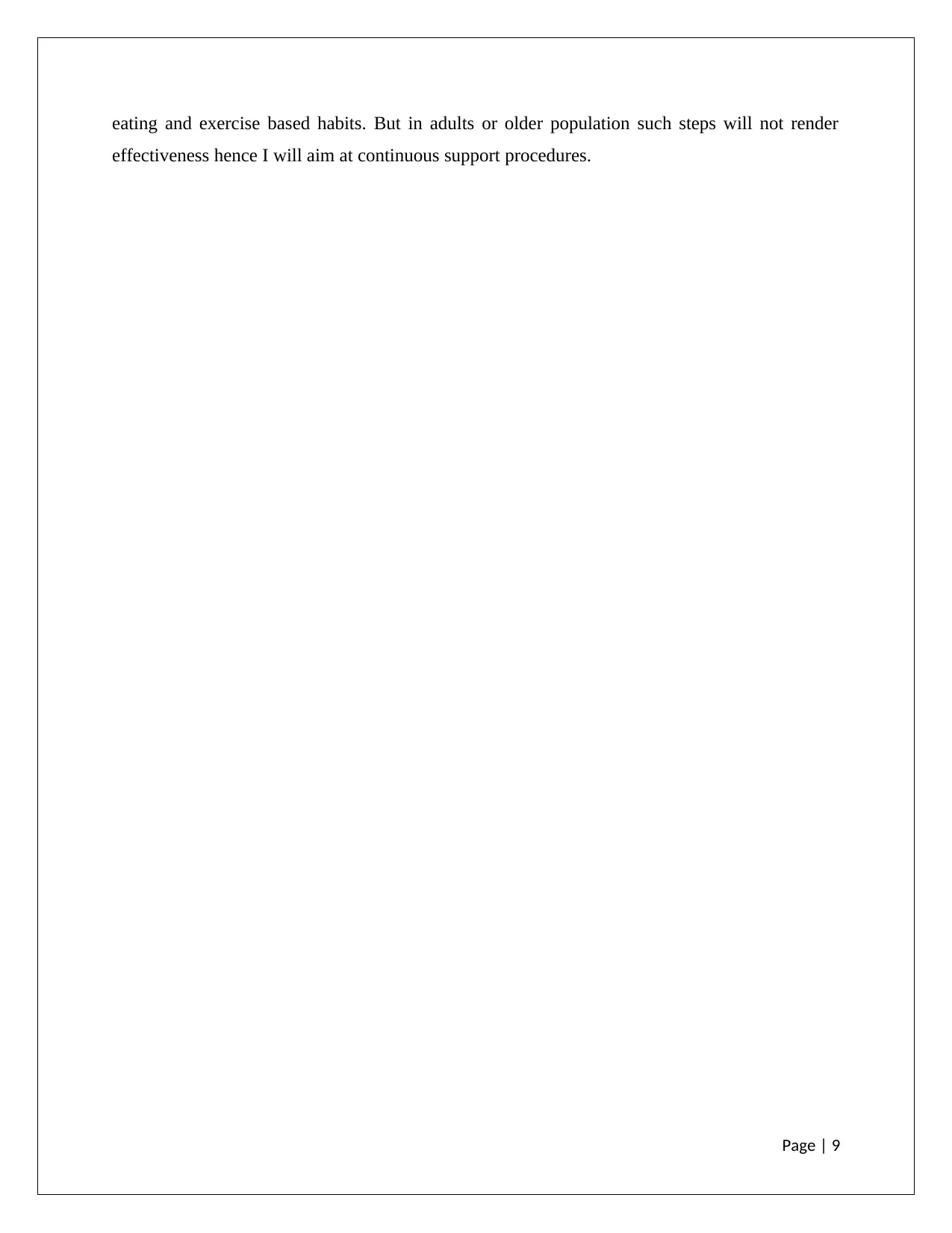
eating and exercise based habits. But in adults or older population such steps will not render
effectiveness hence I will aim at continuous support procedures.
Page | 9
effectiveness hence I will aim at continuous support procedures.
Page | 9
⊘ This is a preview!⊘
Do you want full access?
Subscribe today to unlock all pages.

Trusted by 1+ million students worldwide
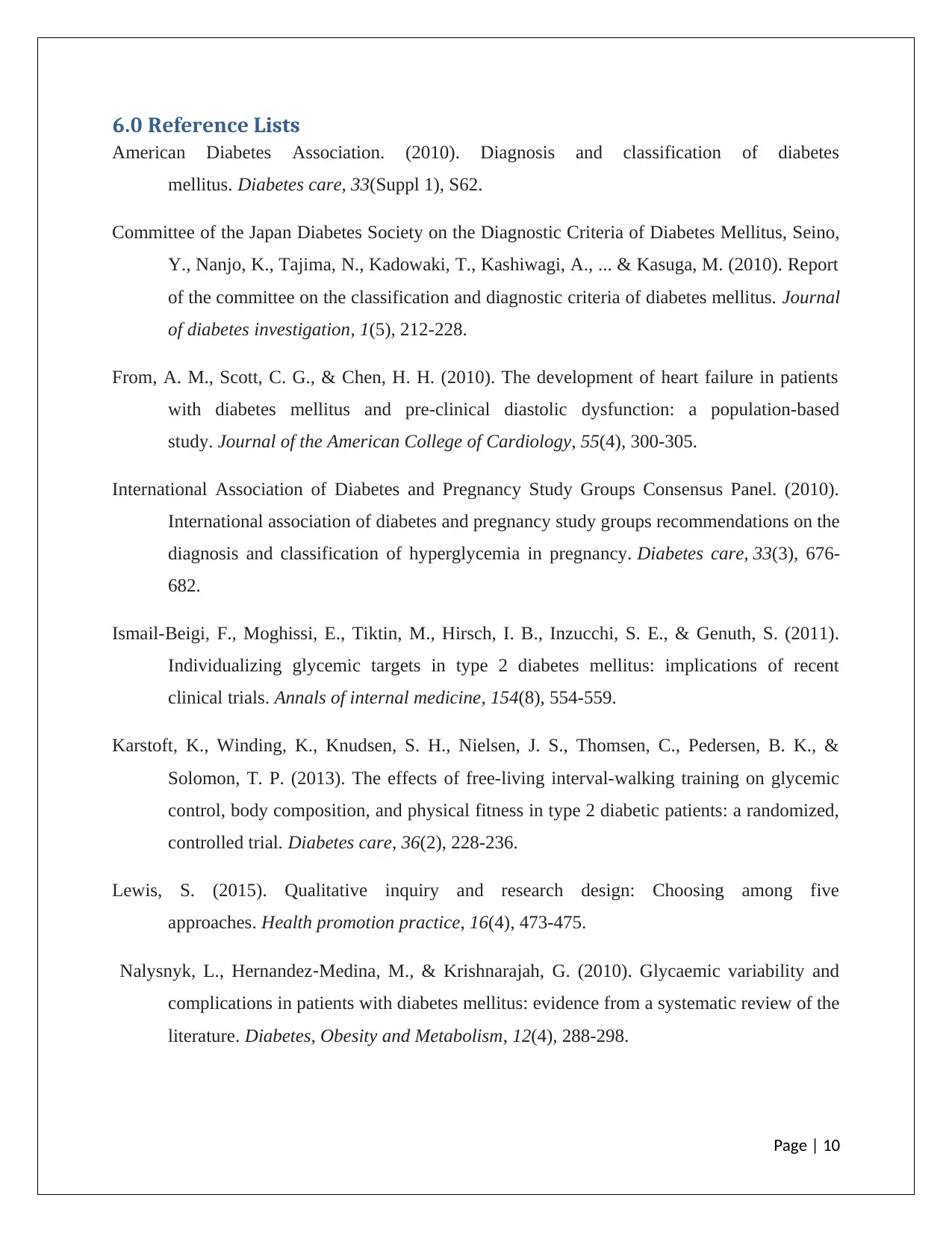
6.0 Reference Lists
American Diabetes Association. (2010). Diagnosis and classification of diabetes
mellitus. Diabetes care, 33(Suppl 1), S62.
Committee of the Japan Diabetes Society on the Diagnostic Criteria of Diabetes Mellitus, Seino,
Y., Nanjo, K., Tajima, N., Kadowaki, T., Kashiwagi, A., ... & Kasuga, M. (2010). Report
of the committee on the classification and diagnostic criteria of diabetes mellitus. Journal
of diabetes investigation, 1(5), 212-228.
From, A. M., Scott, C. G., & Chen, H. H. (2010). The development of heart failure in patients
with diabetes mellitus and pre-clinical diastolic dysfunction: a population-based
study. Journal of the American College of Cardiology, 55(4), 300-305.
International Association of Diabetes and Pregnancy Study Groups Consensus Panel. (2010).
International association of diabetes and pregnancy study groups recommendations on the
diagnosis and classification of hyperglycemia in pregnancy. Diabetes care, 33(3), 676-
682.
Ismail-Beigi, F., Moghissi, E., Tiktin, M., Hirsch, I. B., Inzucchi, S. E., & Genuth, S. (2011).
Individualizing glycemic targets in type 2 diabetes mellitus: implications of recent
clinical trials. Annals of internal medicine, 154(8), 554-559.
Karstoft, K., Winding, K., Knudsen, S. H., Nielsen, J. S., Thomsen, C., Pedersen, B. K., &
Solomon, T. P. (2013). The effects of free-living interval-walking training on glycemic
control, body composition, and physical fitness in type 2 diabetic patients: a randomized,
controlled trial. Diabetes care, 36(2), 228-236.
Lewis, S. (2015). Qualitative inquiry and research design: Choosing among five
approaches. Health promotion practice, 16(4), 473-475.
Nalysnyk, L., Hernandez‐Medina, M., & Krishnarajah, G. (2010). Glycaemic variability and
complications in patients with diabetes mellitus: evidence from a systematic review of the
literature. Diabetes, Obesity and Metabolism, 12(4), 288-298.
Page | 10
American Diabetes Association. (2010). Diagnosis and classification of diabetes
mellitus. Diabetes care, 33(Suppl 1), S62.
Committee of the Japan Diabetes Society on the Diagnostic Criteria of Diabetes Mellitus, Seino,
Y., Nanjo, K., Tajima, N., Kadowaki, T., Kashiwagi, A., ... & Kasuga, M. (2010). Report
of the committee on the classification and diagnostic criteria of diabetes mellitus. Journal
of diabetes investigation, 1(5), 212-228.
From, A. M., Scott, C. G., & Chen, H. H. (2010). The development of heart failure in patients
with diabetes mellitus and pre-clinical diastolic dysfunction: a population-based
study. Journal of the American College of Cardiology, 55(4), 300-305.
International Association of Diabetes and Pregnancy Study Groups Consensus Panel. (2010).
International association of diabetes and pregnancy study groups recommendations on the
diagnosis and classification of hyperglycemia in pregnancy. Diabetes care, 33(3), 676-
682.
Ismail-Beigi, F., Moghissi, E., Tiktin, M., Hirsch, I. B., Inzucchi, S. E., & Genuth, S. (2011).
Individualizing glycemic targets in type 2 diabetes mellitus: implications of recent
clinical trials. Annals of internal medicine, 154(8), 554-559.
Karstoft, K., Winding, K., Knudsen, S. H., Nielsen, J. S., Thomsen, C., Pedersen, B. K., &
Solomon, T. P. (2013). The effects of free-living interval-walking training on glycemic
control, body composition, and physical fitness in type 2 diabetic patients: a randomized,
controlled trial. Diabetes care, 36(2), 228-236.
Lewis, S. (2015). Qualitative inquiry and research design: Choosing among five
approaches. Health promotion practice, 16(4), 473-475.
Nalysnyk, L., Hernandez‐Medina, M., & Krishnarajah, G. (2010). Glycaemic variability and
complications in patients with diabetes mellitus: evidence from a systematic review of the
literature. Diabetes, Obesity and Metabolism, 12(4), 288-298.
Page | 10
Paraphrase This Document
Need a fresh take? Get an instant paraphrase of this document with our AI Paraphraser

Stolar, M. (2010). Glycemic control and complications in type 2 diabetes mellitus. The American
journal of medicine, 123(3), S3-S11.
Page | 11
journal of medicine, 123(3), S3-S11.
Page | 11
1 out of 11
Related Documents
Your All-in-One AI-Powered Toolkit for Academic Success.
+13062052269
info@desklib.com
Available 24*7 on WhatsApp / Email
![[object Object]](/_next/static/media/star-bottom.7253800d.svg)
Unlock your academic potential
Copyright © 2020–2026 A2Z Services. All Rights Reserved. Developed and managed by ZUCOL.




